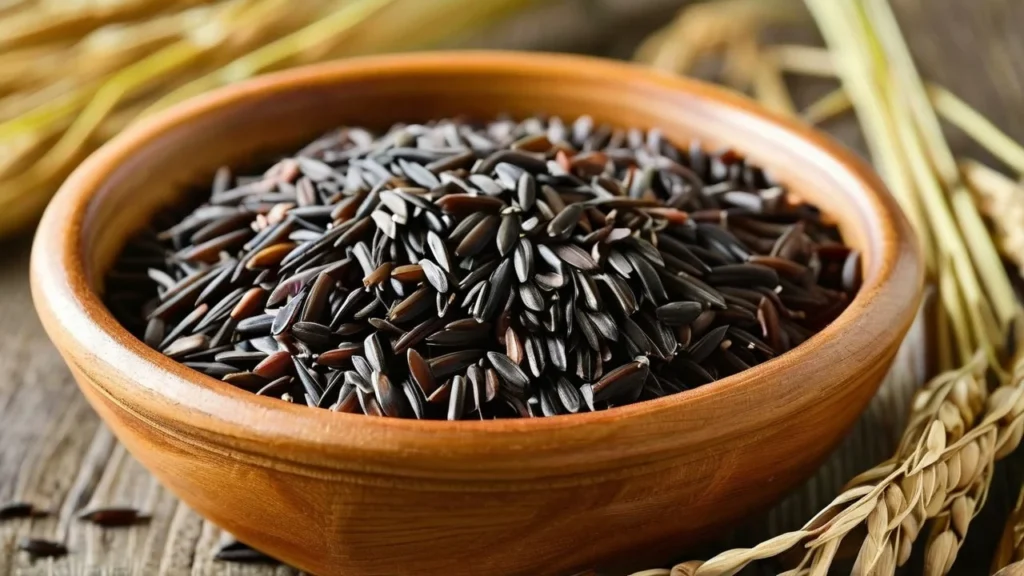Wild Rice: A Nutritious and Versatile Grain
Key Takeaways
- Wild rice is not actually rice but a type of aquatic grass seed, native to North America.
- It is packed with essential nutrients, including protein, fiber, antioxidants, and various vitamins.
- Wild rice is gluten-free, making it an excellent choice for those with gluten intolerance or celiac disease.
- It can be used in a variety of dishes, from soups and salads to side dishes and casseroles.
What is Wild Rice?
Wild rice is a whole grain harvested from aquatic grasses, specifically species in the genus Zizania. Unlike traditional rice, which belongs to the genus Oryza, wild rice is native to North America and has been a staple food for indigenous communities for centuries. Its long, dark grains have a slightly nutty flavor and a chewy texture, making it a popular choice in health-conscious diets.
Nutritional Profile of Wild Rice
Wild rice is considered a nutrient-dense food, offering a wide array of vitamins, minerals, and antioxidants. It is lower in calories than most grains and higher in protein, making it an excellent choice for those seeking a healthy, balanced diet.
Table 1: Nutritional Composition of Cooked Wild Rice (per 100g)
| Nutrient | Amount | % Daily Value (DV) |
|---|---|---|
| Calories | 101 | 5% |
| Protein | 4 g | 8% |
| Fiber | 1.8 g | 7% |
| Carbohydrates | 21 g | 7% |
| Fat | 0.3 g | 0% |
| Magnesium | 32 mg | 8% |
| Zinc | 1.0 mg | 7% |
| Manganese | 0.3 mg | 14% |
| Iron | 0.6 mg | 3% |
Wild rice is also rich in antioxidants, particularly phenolic compounds, which have been linked to reduced oxidative stress and inflammation in the body.
Health Benefits of Wild Rice
Rich in Protein
Wild rice contains more protein than regular white or brown rice. With about 4 grams of protein per 100 grams of cooked rice, it supports muscle growth, tissue repair, and immune function.
High in Antioxidants
Wild rice is a potent source of antioxidants, which help to combat free radicals in the body. These antioxidants have been linked to a reduced risk of chronic diseases such as cancer, heart disease, and type 2 diabetes.
Supports Digestive Health
With nearly 2 grams of dietary fiber per serving, wild rice promotes healthy digestion by aiding in bowel regularity and preventing constipation. Dietary fiber also plays a role in regulating blood sugar levels and lowering cholesterol.
Gluten-Free Grain Option
Wild rice is naturally gluten-free, making it an excellent choice for individuals with celiac disease or gluten intolerance. It provides a nutrient-dense alternative to gluten-containing grains like wheat or barley.
Culinary Uses of Wild Rice
Wild rice is a versatile ingredient that can be used in a variety of dishes, both savory and sweet. Its chewy texture and nutty flavor make it suitable for soups, salads, side dishes, and even desserts.
List: Popular Wild Rice Dishes
- Wild Rice Pilaf: A savory dish where wild rice is cooked with onions, garlic, and broth, often mixed with vegetables and nuts.
- Wild Rice Soup: A creamy, hearty soup made with wild rice, chicken, mushrooms, and aromatic herbs.
- Wild Rice Salad: A refreshing salad featuring wild rice mixed with cranberries, nuts, and a tangy vinaigrette.
- Wild Rice Casserole: A comforting baked dish that combines wild rice with vegetables, cheese, and cream.
- Wild Rice Pudding: A sweet dessert made by simmering wild rice in milk, sugar, and spices like cinnamon and nutmeg.
How to Cook Wild Rice
Cooking wild rice requires more time than traditional rice varieties due to its tough outer shell. However, with the right technique, you can achieve perfectly tender and flavorful grains.
Steps for Cooking Wild Rice:
- Rinse the Rice: Start by rinsing the wild rice under cold water to remove any impurities.
- Boil: Use a ratio of 3 cups of water or broth for every 1 cup of wild rice. Bring the water to a boil.
- Simmer: Reduce the heat to low, cover the pot, and simmer the rice for 45-60 minutes, or until the grains are tender but still slightly chewy.
- Drain: If there’s excess liquid after cooking, drain the rice using a fine-mesh sieve.
- Fluff: Fluff the rice with a fork before serving to separate the grains.
Wild Rice vs. Brown Rice: A Comparison
Wild rice is often compared to brown rice, as both are whole grains and offer similar health benefits. However, wild rice has some distinct nutritional advantages.
Table 2: Nutritional Comparison (Cooked, per 100g)
| Nutrient | Wild Rice | Brown Rice |
|---|---|---|
| Calories | 101 | 112 |
| Protein | 4 g | 2.5 g |
| Fiber | 1.8 g | 1.6 g |
| Carbohydrates | 21 g | 24 g |
| Fat | 0.3 g | 0.9 g |
| Iron | 0.6 mg | 0.4 mg |
| Magnesium | 32 mg | 39 mg |
While both grains are nutritious, wild rice has more protein and fewer carbohydrates than brown rice, making it an appealing option for those looking to cut carbs or increase protein intake.
Environmental Impact of Wild Rice Harvesting
Wild rice is often hand-harvested in lakes and rivers, a tradition practiced by Native American tribes for generations. This method is not only sustainable but also helps to maintain water ecosystems. Unlike commercial rice farming, wild rice harvesting requires no pesticides or fertilizers, reducing its environmental footprint.
List: Benefits of Traditional Wild Rice Harvesting
- Eco-Friendly Practices: Wild rice is harvested using sustainable, low-impact methods that preserve natural ecosystems.
- Supports Biodiversity: Wild rice fields provide habitat for a variety of wildlife, including birds, fish, and amphibians.
- Cultural Significance: Harvesting wild rice is a deeply rooted cultural practice among Native American tribes, promoting the preservation of traditions and livelihoods.
Conclusion
Wild rice is not only a nutritious and versatile food but also a sustainable choice that supports biodiversity and cultural traditions. Whether used in soups, salads, or as a standalone dish, wild rice adds a rich texture and flavor to meals while providing essential nutrients. Its unique nutritional profile, combined with its environmental benefits, makes it a valuable addition to a healthy, balanced diet.
FAQ
1. Is wild rice gluten-free?
Yes, wild rice is naturally gluten-free and suitable for those with gluten intolerance or celiac disease.
2. How does wild rice differ from brown rice?
Wild rice is not technically rice but the seed of aquatic grass. It has a higher protein content and fewer carbohydrates than brown rice.
3. What is the best way to store wild rice?
Store uncooked wild rice in an airtight container in a cool, dry place. Cooked wild rice can be refrigerated for up to 5 days.
4. Can I substitute wild rice for regular rice in recipes?
Yes, wild rice can be substituted in most recipes that call for rice, though it will have a firmer texture and nuttier flavor.
5. How long does it take to cook wild rice?
Wild rice typically takes 45-60 minutes to cook, depending on the desired level of tenderness.











